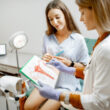For many couples, experiencing a miscarriage is the first time they have ever lost an immediate family member. While we call someone who has experienced the loss of a spouse a widow or widower, and a child who has lost parents an orphan, there is no word to describe a parent who has had a miscarriage. To make things worse, conventional medicine doesn’t seem to have much of an answer for women who experience it, except to try to get pregnant again and hope for the best. But there are answers: fertility charting can tell you a great deal about your risk of a miscarriage before it happens and about ways to resolve root causes.
Five years ago, my fiancé and I were just beginning to learn a natural method of fertility awareness. My only expectation was that we would learn how to avoid and achieve pregnancies and never have the need for hormonal or barrier contraception. Oh, and I was learning a lot about my own body too! Slowly, I began to internalize the difference between previously mysterious terms like ovulation and implantation and estrogen and progesterone. What I did not expect is the role my chart and our appointments with a FertilityCare Practitioner would play in helping diagnose and treat a fairly common reproductive condition that I have: low progesterone or luteal phase deficiency.
Some of the signs of progesterone deficiency include brown or black bleeding before or at the tail end of the menstrual period; fewer than 8 days between ovulation and the next menstrual period; and in some cases, PMS symptoms. Progesterone (from the corpus luteum) helps the process of implantation and growth of the baby if conception takes place. If no conception takes place, the corpus luteum causes the next menstrual period to be productive and efficient in shedding the endometrial lining. Timed blood tests can confirm whether you have a hormonal imbalance.
The diagnosis of my low progesterone came nearly six months before my wedding and so we began working with a NaPro Technology doctor to treat this condition. Although we hoped to begin trying to become pregnant right away once married, we were advised to wait until my progesterone levels increased and stabilized. I trusted this medical advice. After all, I wanted any future child to have the best chance possible.
Once I internalized and accepted this information, I began to make positive steps toward improving my health. “Hustle while you wait” became my mantra and I began taking bioidentical progesterone orally, using my chart to help me know when to take it following ovulation each cycle. I also began reducing toxins in my day-to-day life, using cloth menstrual pads and organic cotton tampons during my periods, and paying more attention to my nutrition. I was previously a vegetarian and ate a lot of processed soy (labeled soy protein isolate) in imitation meat products. Once I learned that processed soy is linked with causing estrogen dominance, and subfertility, I began to consume healthier alternative sources of protein like eggs, fish, and plant protein.
Once my levels improved, we conceived in the very first cycle we tried. Unfortunately, two days after my positive pregnancy test and bloodwork, I began to bleed, and it was apparent that I was experiencing an early miscarriage. I was devastated. How could this happen? Amidst the sorrow and grief, I was grateful to know that the miscarriage had not been caused by a lack of progesterone, since my levels had been so carefully monitored. Other common causes of miscarriage include chromosomal abnormalities, blood clotting disorders, diabetes, thyroid issues, immunological factors, structural issues, and occasionally lifestyle factors (such as heavy drug or alcohol use).
In the next three months, my husband and I grieved the loss of our child whom we named Perfecta Marie. We were both heartbroken and disappointed. Was my body broken? We continued to pay close attention to my chart and by working with my physician, we began trying to have another child. Two cycles later, we conceived our son, Teddy.
I received bioidentical progesterone through 36 weeks of pregnancy in various forms, including oral medication, vaginal suppositories, and intramuscular injections. The injections were not glamorous; I had bruises and welts on my buttocks that made me waddle around like a penguin. I dreaded the injections, yet I felt empowered that this medication was allowing me the opportunity to become a mother. Teddy was born six days before his due date in April 2014, and is an incredibly healthy, active toddler.
 We are currently expecting again, and I am having blood draws every two weeks to monitor my levels while taking progesterone. We consciously chose to postpone pregnancy in my early postpartum cycles because we knew that our risk of miscarriage in those cycles was potentially higher, based on how short my luteal phase was. I weaned my son at 15 months before we conceived our next child, thanks to fertility awareness.
We are currently expecting again, and I am having blood draws every two weeks to monitor my levels while taking progesterone. We consciously chose to postpone pregnancy in my early postpartum cycles because we knew that our risk of miscarriage in those cycles was potentially higher, based on how short my luteal phase was. I weaned my son at 15 months before we conceived our next child, thanks to fertility awareness.
My only regret is that I did not start charting or making lifestyle modifications sooner! I encourage single women to begin charting their cycles in their young adulthood and even in their teenage years. The sooner a woman works with a fertility awareness instructor, the sooner cycle irregularities can be detected. With this knowledge and the guidance of a medical provider, diet, exercise, and medicine regimens can be implemented.
If you hope to become pregnant someday and want to minimize your risks of miscarriage, consider learning how to chart your cycles today. If you have had one or several miscarriages, take hope in this information as you may benefit from working with a NaPro Technology doctor. The woman’s body is at its best when her hormones are in balance, and this leads to healthier cycles and healthier pregnancies.
More information
How Fertility Awareness Reduces the Risk of Miscarriage
Flo Living — A website dedicated to good nutrition that supports the fertility cycle











